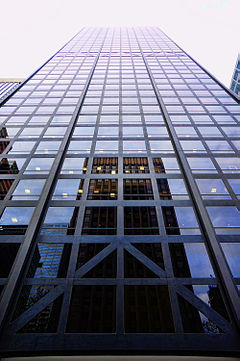140 William Street
| 140 William Street, Melbourne | |
|---|---|

Building façade from William Street
|
|
| Record height | |
| Tallest in Melbourne from 1972 to 1975 | |
| Preceded by | Marland House |
| Surpassed by | Optus Centre |
| General information | |
| Location |
Melbourne, Victoria, Australia 140 William Street in the CBD |
| Coordinates | 37°48′57″S 144°57′31″E / 37.8158°S 144.9586°ECoordinates: 37°48′57″S 144°57′31″E / 37.8158°S 144.9586°E |
| Completed | 1972 |
| Height | |
| Roof | 152 metres (499 ft) |
| Technical details | |
| Floor count | 41 |
| Design and construction | |
| Architect | Yuncken Freeman |
| Engineer | Irwin Johnson & Partners |
140 William Street (formerly BHP House) is a 41-storey steel, concrete and glass building located in the eastern side of the central business district of Melbourne, Victoria, Australia. Constructed between 1969 and 1972, BHP House was designed by the architectural practice Yuncken Freeman alongside engineers Irwin Johnson and Partners, with heavy influence of contemporary skyscrapers in Chicago, Illinois. The local architects sought technical advice from Fazlur Khan of renowned American architectural firm Skidmore, Owings & Merrill (SOM), spending 10 weeks at their Chicago office in 1968. At the time, BHP House was known to be the tallest steel framed building and the first office building in Australia to use a “total energy concept” – the generation of its own electricity using BHP natural gas. The name BHP House came from the building being the national headquarters of the Broken Hill Proprietary (BHP) Company. Since being erected, BHP House has been included in the Victorian Heritage Register (Number H1699) for significance to the State of Victoria for following three reasons:
Containing 41 floors and standing at 152m tall, BHP House was designed in a ‘Modern Style’ during the 1960s. At the time, the design was intentionally promoting the use of steel in Australian construction and sought to establish new national height standards for a steel-framed structure. Consisting of three dominant materials - steel, concrete and glass - 'BHP House was in fact the tallest building in the city upon completion. The buildings ‘sheer glazed curtain wall’ was juxtaposed by banded curtain walls of the 1950s and 1960s and thus was often compared to the works of Mies van der Rohe, due to its detachment from surrounding cityscape, and its presence as a ‘three dimensional sculptural monument’. In the architectural field, BHP House is regarded as one of the more notable projects by Yuncken Freeman Architects due to cutting edge techniques for an office building such as flush glazing, minimalist interiors and expressed structural bracing.
...
Wikipedia
